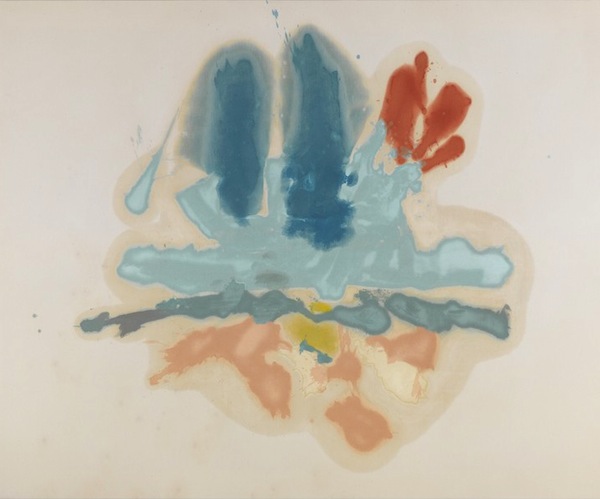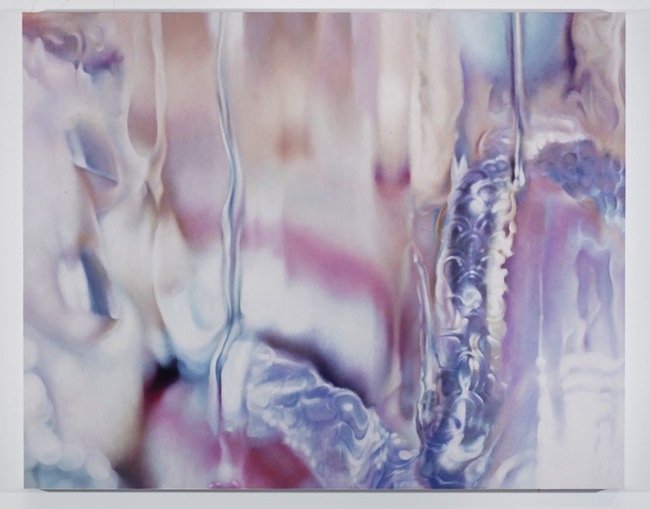Visual Arts Review: “Pretty Raw” at the Rose Art Museum
Nothing takes center stage except the canvases by Helen Frankenthaler, which invite comparisons to every other piece in “Pretty Raw” and demolish the majority of them.
Pretty Raw: Around and After Helen Frankenthaler at the Rose Art Museum, Brandeis University, Waltham, MA, through June 7.

Helen Frankenthaler, “Hommage à M.L.,” 1962. Helen Frankenthaler Foundation © copyright 2015 Helen Frankenthaler Foundation, Inc./Artists Rights Society (ARS), New York. Photograph courtesy Gagosian Gallery
By Franklin Einspruch
Back when the Rose Art Museum was undergoing its travails circa 2009-11, inflicted upon it by a troglodytic decision by then-president of Brandeis Jehuda Reinharz to sell its collection in order to make up for the losses in the university’s endowment after the Great Recession, I felt that a principle had been violated but I couldn’t work up much outrage over the potential loss of the museum itself. Excepting one excellent de Kooning from the ’60s, I knew the collection through minor works, largely on paper, from later decades, perused alongside a 2009 show of Hans Hoffman hung on strange, accordion-style metal dividers. The institution’s defenders argued that it had given an early museum exhibition to Dana Schutz, who had just enjoyed a couple of years of art-world stardom to which I paid little attention. She is now relatively out of the news. There had been recent shows by Matthew Barney and Fred Tommaselli for which I wouldn’t have left the house. I crossed my fingers and hoped for the best instead of answering the call to arms that sprang up around the flap.
Brandeis smartly got rid of Reinharz instead of the Rose, and installed in the directorship Christopher Bedford, a wunderkind who had risen with alacrity through the curatorial ranks at the Getty, LACMA, and the Wexner Center at Ohio State University. Bedford has been pursuing an ambitious program at the Rose since then. It must be said that to date this program has been preponderantly Californian (Bruce Conner, Ed Ruscha, Walead Beshty, Chris Burden, Mark Bradford, John Altoon) and features some distressing redundancy with that of the Institute of Contemporary Art, Boston (Bradford again and Mary Reid Kelly). Still, the Rose feels like a museum in a way that it didn’t in 2009, credit for which goes more to Bedford than the handsome and needed renovations to the galleries carried out prior to his arrival.
It turns out that I was wrong about the collection. It has holdings strong enough to mount Pretty Raw: After and Around Helen Frankenthaler, which recently opened in the Lois Foster Gallery. The core concept, to take the artist “as a lens through which to refocus our vision of modernist art over the past 50 years,” presumably causes “decoration, humor, femininity and masculinity, the everyday, pleasure, and authorial control [to] take center stage.” Which is to say, nothing takes center stage except the canvases by Frankenthaler, which invite comparisons to every other piece in the show and demolish the majority of them.

Marilyn Minter, “Edwina,” 2015, enamel on metal. Courtesy of the artist and Salon 94, New York.
Pretty Raw could be improved by removing half of the objects on display in favor of the ones that stand up in at least some way to the titular artist’s authoritative commitment to her medium. This show was not the occasion to explore authorial control or “the everyday.” Neither Kara Walker’s Rorschach inkblots nor Christopher Wool’s Rorschach inkblots nor Andy Warhol’s Rorschach inkblots belong here — including all of them borders on contemporary-art comedy. Strike the Felix Gonzalez-Torres curtain of beads, the 2003 canvas by (yet again) Mark Bradford, the Ulrike Müller pendants, and the ceramics by Kathy Butterly. Set the Carroll Dunham painting and its anal-explosive puerility on fire and mail back the ashes.
Then, lose the themed spaces, or at least some of these themes. There’s a room devoted to feminism and another called “The Men’s Room,” a double-entendre noting its male artists while referring to the Warhol oxidation painting, from the series in which he peed on canvases coated with a reactive metallic paint. This is an implicit insult to Frankenthaler. Her modus operandi was beating men at their own game. That, full stop, was the extent of her feminism. She had no use for feminist art per se. Head, a 1993 video of Cheryl Donegan manipulating milk with her mouth in such a way that repeatedly evokes the concluding event of fellatio, appears to be taking place in front of a canvas with red stains on it, but the effect is to underscore how little Frankenthaler’s paintings have dated in comparison. The underlying irony is that Donegan’s recent work has been paintings, using thin acrylics and dyed fabric. Why not show them?
Even among the half of the works here that feel apropos there are some dogs. Ten years ago Laura Owens’s paintings were at times touching and engagingly self-aware about the late state of the medium. Now they’re malformed idiocies consisting of nothing except self-consciousness about the late state of the medium, and her outsize piece in oil, resin, charcoal, and gesso on linen from 2014 is no exception. This archness is echoed in the canvas hanging next to it by Mary Weatherford, someone who seems to have some feeling for paint but hangs neon from her canvases as if they were flags of surrender on the battlefield of abstraction.

Jackie Saccoccio, “Portrait (Acid),” 2014, oil and mica on linen, courtesy of the artist and Eleven Rivington.
The bad news about this show is dismaying, but the good news is commensurately sanguine. Among the historical works there is a worthy, Matissean still life by Nell Blaine from 1957 in the museum collection, a lush and verdant Grace Hartigan, an atmospheric Jane Freilicher abstraction, and a grouping of Morris Louis, Lydia Benglis, and Friedel Dzubas that works to each of their mutual benefit. A long stretch of charmingly hand-painted fabric, hung from the two-story ceiling of the gallery, is preserved from Robert Kushner’s 1978 performance Layers, and presented alongside a video of it. (Ah, to have been present when performance art in varying degrees of undress had not yet devolved into an art-school cliche.)
Among the contemporary works there is a strong 2013 painting, Four Dreams in an Open Room by Carrie Moyer. Moyer is a major figure of art-world feminist activism whose work has taken her into a style of textured, intensely colored, hard-edge abstraction. A recent canvas by Marilyn Minter is atypically high-key but fits in with the recurring pastel palette on display throughout the show. The contemporary room introduced me to the work of Hildur Ásgeirsdóttir Jónsson, who produces silk textiles with evocative atmospheres and ambiguous forms woven into them. The Jackie Saccoccio from 2014 is a complete knockout. Portrait (Acid) is painted with oil and mica on linen and it’s eight feet of everything you could want from painterly abstraction, drips, pours, throws, boldness, and verve.
Then there are the Frankenthalers themselves. These would be obvious achievements even without their display alongside a great lot of well-meaning but ultimately not so fruitful effort, especially with decades of hindsight. Hommage à ML from 1962 offers a bravely simple serving of watery shapes, the oil soaking out of them into the surrounding canvas in a way that shades it and creates a subtle container for the colors. Note that she invented this technique, and thus opened an avenue in painting that artists are still traveling, toward their own discoveries.
Franklin Einspruch is a Boston-based artist and writer. His website is einspruch.com; follow him on Twitter @franklin_e.
Tagged: abstraction, Around and After Helen Frankenthaler, Christopher Bedford, Helen Frankenthaler, Pretty Raw
